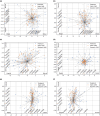Evaluation of the Accuracy, Surgical Time, and Learning Curve of Freehand, Static, and Dynamic Computer-Assisted Implant Surgery in an In Vitro Study
- PMID: 39835464
- PMCID: PMC12066894
- DOI: 10.1111/clr.14403
Evaluation of the Accuracy, Surgical Time, and Learning Curve of Freehand, Static, and Dynamic Computer-Assisted Implant Surgery in an In Vitro Study
Abstract
Objectives: This experimental study compared the accuracy of implant insertion using the free-hand (FH) technique, static computer-aided surgery (S-CAIS), or dynamic computer-assisted surgery (D-CAIS) and to evaluate the correlation of learning curves between surgeons' experience and surgical time.
Materials and methods: Thirty-six models were randomly assigned to three groups (FH, n = 12; S-CAIS, n = 12; D-CAIS, n = 12). Each model was planned to receive four implants in the maxillary anterior and posterior regions. Twelve participants, six experienced surgeons, and six dental students were included in this study. The primary outcome was the deviation between the planned and final implant placement from each group. Secondary outcomes were each technique's learning curve regarding surgical time.
Results: The average deviation at implant platform, apex and gradual deviation with FH technique were 1.31 ± 0.88 mm, 1.75 ± 0.9 mm and 6.67° ± 3.70°, respectively. The average deviation of implant platform, apex and angular in S-CAIS were 0.67 ± 0.32 mm, 1.00 ± 0.39 and 2.66° ± 1.77°, respectively. The average deviation of implant platform, apex and angular in D-CAIS were 1.14 ± 0.70 mm, 1.23 ± 0.58 and 3.20° ± 2.16°, respectively. Significant discrepancies at the implant platform, implant apex, and angular deviation were found between all surgical methods (p < 0.016). Learning curves were evident after multiple implant insertions using both freehand and S-CAIS.
Conclusion: The findings indicate that computer-assisted implant insertion leads to a more precise implant alignment than implants inserted freehand in an experimental set-up.
Keywords: computer‐aided implant surgery; implant accuracy; learning curve; surgeon‐reported outcome; surgical time.
© 2025 The Author(s). Clinical Oral Implants Research published by John Wiley & Sons Ltd.
Conflict of interest statement
The authors declare no conflicts of interest.
Figures







Similar articles
-
Freehand vs. computer-aided implant surgery: a systematic review and meta-analysis-part 1: accuracy of planned and placed implant position.Int J Implant Dent. 2025 May 2;11(1):35. doi: 10.1186/s40729-025-00622-w. Int J Implant Dent. 2025. PMID: 40314873 Free PMC article. Review.
-
Accuracy of implant placement using a mixed reality-based dynamic navigation system versus static computer-assisted and freehand surgery: An in Vitro study.J Dent. 2024 Jul;146:105052. doi: 10.1016/j.jdent.2024.105052. Epub 2024 May 9. J Dent. 2024. PMID: 38734298
-
Comparison of the accuracy of implant position among freehand implant placement, static and dynamic computer-assisted implant surgery in fully edentulous patients: a non-randomized prospective study.Int J Oral Maxillofac Surg. 2023 Feb;52(2):264-271. doi: 10.1016/j.ijom.2022.05.009. Epub 2022 Jun 23. Int J Oral Maxillofac Surg. 2023. PMID: 35752531
-
The accuracy of implant placement using a combination of static and dynamic computer-assisted implant surgery in fully edentulous arches: A prospective controlled clinical study.Clin Oral Implants Res. 2024 Aug;35(8):841-853. doi: 10.1111/clr.14185. Epub 2023 Sep 26. Clin Oral Implants Res. 2024. PMID: 37750503
-
The Accuracy of Zygomatic Implant Placement Assisted by Dynamic Computer-Aided Surgery: A Systematic Review and Meta-Analysis.J Clin Med. 2023 Aug 21;12(16):5418. doi: 10.3390/jcm12165418. J Clin Med. 2023. PMID: 37629460 Free PMC article. Review.
Cited by
-
Computer-Assisted Implant Surgery: Implications for Teaching, Learning, and Educational Strategies.Clin Exp Dent Res. 2025 Aug;11(4):e70197. doi: 10.1002/cre2.70197. Clin Exp Dent Res. 2025. PMID: 40741829 Free PMC article. Review.
-
Accuracy of Three-Dimensional Computer-Aided Implant Surgical Guides: A Prospective In Vivo Study of the Impact of Template Design.Dent J (Basel). 2025 Mar 29;13(4):150. doi: 10.3390/dj13040150. Dent J (Basel). 2025. PMID: 40277480 Free PMC article.
-
Freehand vs. computer-aided implant surgery: a systematic review and meta-analysis-part 1: accuracy of planned and placed implant position.Int J Implant Dent. 2025 May 2;11(1):35. doi: 10.1186/s40729-025-00622-w. Int J Implant Dent. 2025. PMID: 40314873 Free PMC article. Review.
References
-
- Edelmann, C. , Wetzel M., Knipper A., Luthardt R. G., and Schnutenhaus S.. 2021. “Accuracy of Computer‐Assisted Dynamic Navigation in Implant Placement With a Fully Digital Approach: A Prospective Clinical Trial.” Journal of Clinical Medicine 10, no. 9: 1808. 10.3390/jcm10091808. - DOI - PMC - PubMed
Publication types
MeSH terms
LinkOut - more resources
Full Text Sources
Miscellaneous

